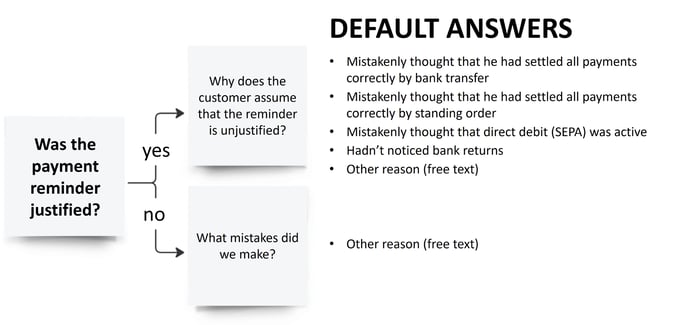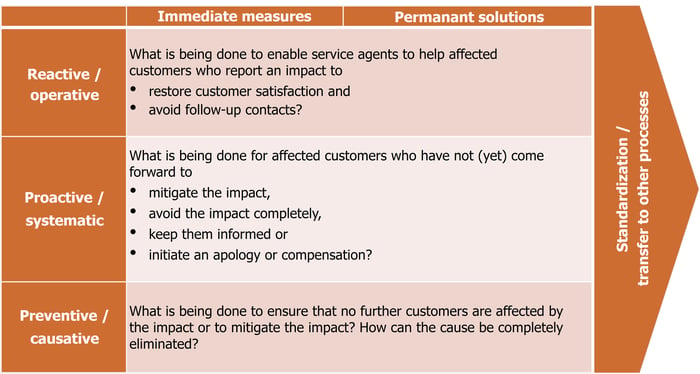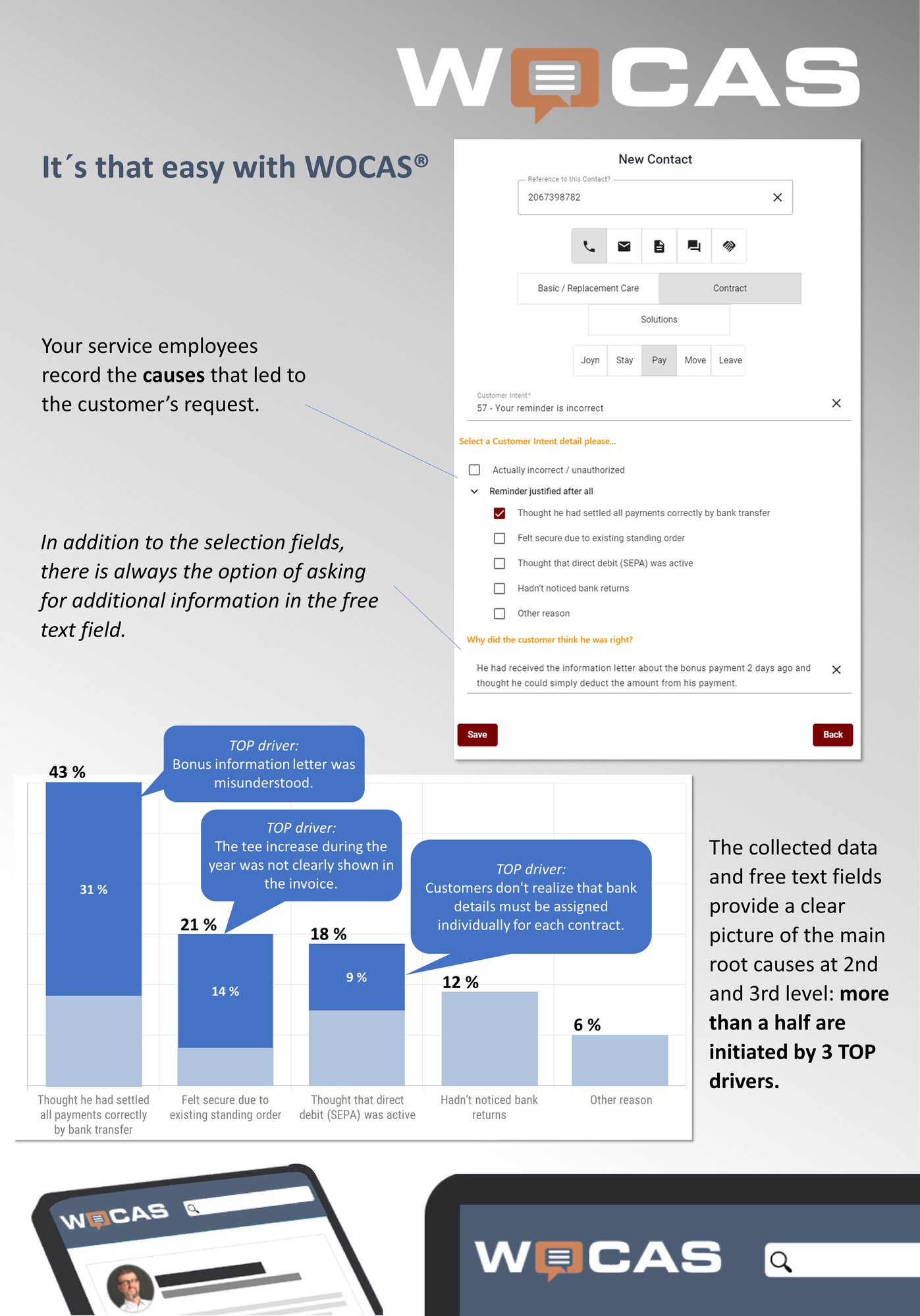
Untagling the corporate tangle: by searching for and eliminating the causes of problems
Typical analyses of customer contacts show that the greatest potential for contact reduction lies in eliminating the causes of customer concerns that neither generate added value nor inspire customers. Although this insight promises a win-win situation, identifying the causes of problems often proves to be a challenge in practice.
Gründe dafür sind versteckte Ursachen, fehlende Daten und kulturelle Faktoren. Um dies zu überwinden, empfehlen wir einen systematischen Ansatz, der eine Datenanalyse, Hypothesentests und die Einbeziehung von Experten – insbesondere von Kundenservice-Mitarbeitern im Rahmen der Kontaktbearbeitung – umfasst.
Was ist das Problem?
The most promising potential for contact reduction often lies in the concerns that are annoying for customers and for which companies have to spend budget on customer contact but cannot generate any added value. Eliminating the causes of these concerns therefore represents a classic win-win situation for companies and customers.
Sounds good, doesn't it? In practice, however, companies rarely succeed in getting to the root of the problem and eliminating it sustainably. Identifying the exact causes of the problem (root cause analysis) can be difficult for various reasons, e.g. hidden causes, associated problem factors, missing data, human error, corporate culture. As a result, the wrong problems are often addressed, which then do not contribute to the goals set.
To address these challenges, it is important to take a systematic approach to root cause analysis. In our experience, this includes gathering relevant customer insights, involving customer service employees in the contact handling process, involving subject matter experts and agile testing of hypotheses to confirm or rule out possible causes.
The use of tools such as cause-and-effect diagrams, fault tree analyses, the 5 Why method or other analysis techniques can help to better identify and understand the causes of problems.
Searching for problems and causes
Let's use an example to make the variety of problems and causes more tangible:
A contact analysis at an energy supplier shows that a significant proportion of customer contacts relate to the concern "Your payment reminder is incorrect/unjustified". A team is tasked with identifying and eliminating the causes of this concern.
As part of a root cause analysis, a targeted deepening of the contact analysis is carried out specifically for the concern "Your payment reminder is incorrect/unjustified". This shows that more than a quarter of all contacts are triggered by a current information letter "With your bonus you pay 20 euros less". In this letter, customers are informed about an upcoming bonus payment. The contact analysis shows that this wording leads to many customers reducing the subsequent discount and therefore receiving a payment reminder. In reality, however, the bonus payment is only offset with the next bill.
The obviously misleading wording of the information letter prompted a closer examination of the quality assurance process for customer letters. It turns out that the company has no proofreading process for new or revised customer letters and that the employees responsible for new customer letters have never been trained in customer-oriented communication.
The department head responsible shows no understanding of the need for customer-oriented communication. Phrases such as "...if the customers are too stupid..." show the prevailing culture in this area.
This results in the following chain of causes with regard to the information letter:
- lack of customer orientation at management level
- lack of employee communication training
- a lack of quality assurance process for customer letters
- the timing of the information letter
- the specific wording "With your bonus you pay 20 euros less.“
This list is not exhaustive, as there are other reasons for this request.
MaSome projects easily get lost in the corporate tangle in the search for root causes. A conscious decision therefore needs to be made as to how broadly and deeply the root cause analysis is carried out. It is advisable not to analyze with the aim of completeness, but to work according to the Pareto principle (80/20 rule) and to timebox the analysis process.n.
Search for causes in a structured manner
Instead of tackling the superficial symptoms of a problem, root cause analysis digs deeper to uncover the root causes.
First, one or more customer concerns are selected for a root cause analysis. Companies structure the analysis phase very differently depending on their size and resources: In smaller companies, individual employees are often commissioned to carry out the analysis. Larger companies or corporations use entire analysis teams (e.g. analysis squads, attack teams) for root cause analysis. These teams are ideally interdisciplinary or are actively supported by
- Business owner of the issue
- Process and system specialists
- Customer experience experts
- Employees in customer service (sample team „customer researchers“)
- Business analysts in customer service
A first step in the deep dive analysis is to break down the customer concern on the second and third levels. How does this breakdown work?
Let’s take a look at the breakdown using the example of our target concern “Your payment reminder is incorrect/unauthorized”. Initially, no valid conclusions can be drawn about the possible causes. There are a few assumptions, but no causes confirmed by customer interactions.
This is where the sample team of service employees comes into play. This team has exclusive access to customers with our target concern “Your payment reminder is incorrect/unauthorized”. No one else in the company interacts with the customer when they want to clarify their concerns. No one else in the company can capture and document important information from this interaction.
Therefore, the members of the sample team receive a recording tool according to the specifications of the analysis team with in-depth questions and initial answer requirements (hypotheses) as well as additional questions for free text to form new hypotheses).
Example:

After an initial review of the answers, the analysis team can see which answers are chosen more often and which ones are chosen less often. Answers chosen less often can be ignored, while more detailed questions can be asked if answers are chosen more frequently. The free texts often give rise to new hypotheses that change the direction of the analysis. The initial set of answer specifications changes as the hypotheses are tested in customer contact in agile interaction between the analysis team and the sample team.
After a short time, the information letter “appears” more often in the free text answers. The analysts include the information letter in the response templates and can thus determine how often customers have contacted the company based on the information letter.
The role of the customer service business analyst
The customer service business analyst is the interface between analysis and the sample team. His tasks are
- Ensuring that sample team members understand exactly what information is needed from the customer and are able to collect and document this information.
- to ensure the right balance between interest in knowledge and productivity.
Once the essential aspects of the customer concern have been identified (breakdown on 2nd and 3rd levels) and the causes from the customer's perspective have been identified, in the second step the analysis team directs its analysis focus on the causes from the company's perspective . This is the hour of the CX, process and system specialists.
Find effective solutions
As soon as the causes have been sufficiently identified from the customer and company perspective, the search for effective solutions for all or selected causes begins.
The selected causes can lie in different areas of the company and require different solution expertise. Correcting a process error that, under certain circumstances, leads to an incorrect credit on the invoice requires different expertise than designing and implementing a change program for greater customer orientation in customer communication. Some (larger) companies take this as an opportunity to form one or more cause-specific solution teams.
The development of good and effective solutions can be accelerated if customer service is involved in order to test solution approaches and ideas with affected customers in customer contact at an early stage. The acceptance of solutions can be tested, for example, by asking “Would solution XY have helped you in this specific situation or avoided contact?”
And what if it takes longer?
Solutions are always very individual and tailor-made for the company, its products, employees and processes. It often takes weeks, months or years until the causes of the problem that have been identified and analyzed can be solved. During this time, the impact of the problems for customers (satisfaction and loyalty to the company) and companies (service costs) remains.
Therefore, it may be important to think about reactive and proactive interim solutions: How can service employees be empowered to help affected customers in order to restore their satisfaction and avoid follow-up contacts?
Examples:
- Increase the grace limit for quick credit in the event of errors - before the customer has to wait a long time for the error to be corrected manually.
- “Warn” the customer that a standardized confirmation of the credit will be sent by email the next day, which in this case is misleading but unfortunately cannot be suppressed.
- If necessary, provide a ready-made, customer-oriented email that summarizes the facts and a request for an apology.
How can affected customers who have not (yet) reported be proactively supported in order to mitigate the impact or prevent the problem for customers in advance?
Examples:
- Identify customers affected by the error in the database and proactively inform them..
- If necessary, create a credit note with an explanation and apology.

"So, how did I do?" - Checking solutions for effectiveness
Now it is important to provide concrete evidence of the economic benefits of the implemented solutions. A simple before and after comparison of the absolute number of contacts is often intended to “prove” success. However, in volatile business environments, this approach is rarely precise enough and often does not stand up to critical scrutiny.
In our WOCAS Practice Guide #05 (-> WPG#05) we show how the success of solutions can be proven precisely and objectively using contact rates. Contact rates are easily measurable and comprehensible quotients that relate the number of contacts to a certain quantity X.
Another benefit of using contact rates is the ability to set smart goals (specific, measurable, achievable, relevant and time-bound) and demonstrate long-term trends through repeated measurements.
.
How WOCAS® can support you in analysis and solution implementation
We help you not to get lost in the corporate tangle. With our WOCAS® application you have the optimal tool for root cause analysis and the breakdown of customer concerns on the 2nd and 3rd levels. You orchestrate the tasks of the various teams, organize the close exchange between the sample and analysis teams in a targeted manner and can carry out effectiveness measurements without much effort after the solutions have been implemented.

Feedback
We would be very glad to receive likes and comments or if you share our practice tip to make it accessible to other interested parties. You can do this by following our LinkedIn company page.
Want to talk to us? - Great!
We look forward to hearing about your challenges in a non-committal conversation and finding out together how WOCAS can help you.
